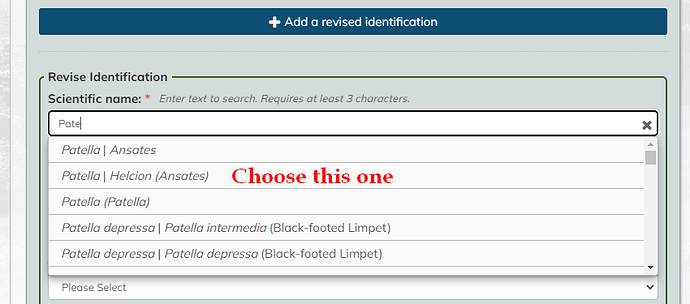Yes, that’s not unheard of I’m afraid. Some of these instances make no sense at all whereas others appear to be someone erring on the side of caution.
Always the case, even with the Old Dictionary.
There REALLY is a need to concentrate on the glaring errors in Browser Grouping (it IS a Grouping issue)
And, as another example one might think there are no iSpot Mites for example Arachnida | Species Dictionary | UK and Ireland | iSpot Nature
I honestly feel that we must not rely on finding such things by accident - there is plenty of historical evidence for glaring errors
This general issue needs a consolidated and unified approach before moving onto another subject.
There ARE over 12 Thousand Aarachnida Observations - perhaps find the ones with that precise ID…
this has been running since January - comment and ideas are welcome - updated a little today ▶️Using the Dictionary Menu◀️ | Project | UK and Ireland | iSpot Nature
an error in ASCI-space coding @miked . There are other examples. I have left a note in the Observation.
I do so hope that these errors are being passed to the Curator of the NHM Index which is surely due for an overhaul…
Eristalis intricaria NHMSYS0021385413
Another oddity in Eupeodes: choosing just ‘Eupeodes’ from the drop-down doesn’t appear to link to all observations of all Eupeodes - see these two done today, which only have 4 other obs:
I can see now that there are 5 options for ‘Eupeodes’ in the drop-down so presumably not all of them link up:
it is always worth a Browse in the Browser to see what others there are or who might have spotted it before.
Eupeodes | Species Dictionary | UK and Ireland | iSpot Nature It has been an issue since 2015 but may have been a simple spelling error
?Eupodes hoverfly | Observation | UK and Ireland | iSpot Nature
.
Eupeodes A is a species, according to the NHM - Species Dictionary | Natural History Museum
And there is a Sub-genus called Eupeodes - Species Dictionary | Natural History Museum
Cool eh?
.
Care is needed when selecting from the drop-down
Genus Eupodes Koch, 1835 is this Eupodes Koch, 1835
Genus Eupeodes Osten Sacken, 1877 is Eupeodes Osten-Sacken, 1877
But all the ones in your Screenshot are viable (and correct) Right of a vertical slash is always a synonym. Anything in (Brackets) is a Common Name. Eupeodes A should be avoided.
.
It seems to be a mess, as there are over 500 Observations in the Genus yet only 5 in Other Obs.
It may be that those IDd to genus only are kept separate - I think that is unusual in the Browser.
@miked
.
Another example of difficulties that were probably present before the New Dictionary was installed.
some jolly Scientific names here Equus ferus | Species Dictionary | UK and Ireland | iSpot Nature
Balsamiaceae is a fungus family in the cup-fungi Pezizales @miked (My error) Fungi | Species Dictionary | UK and Ireland | iSpot Nature
but is has not gone from the Browser anyway.
The variable types of item especially for animals are due to certain organisations asking for them to be included, it is also possible that these might be removed.
A typo here in the common name, noticed by Thistle:
pidgeon is a known variant spelling (wiktionary describes it as archaic)
Users are still using the Common name to access the dictionary and NOT looking to the Scientific name
More and more Organisms are producing split listings in the Browser
Today Back to the Blue | Observation | UK and Ireland | iSpot Nature
Once they are locked by agreements nothing can be done - I have added a couple of plain IDs that need a banner shift
.
https://www.ispotnature.org/communities/uk-and-ireland/view/project/817720/
I seem to have problems entering ladybirds. If I type 22-spot, I’m not offered any options. but if I put in the scientific name, it then offers 22-spot as the vernacular name (same with 16-spot, 14-spot etc).
It’s frustrating as the scientific names go on for ever. 22-spot is Psyllobora vigintiduopunctata - supporting my theory that the smaller the creature, the longer the scientific name!
I have a theory to account for that
Fickle
You need to stroke Dictionary entries gently
By all means test the whole name Polygonia c-album or 22-Spot Ladybird but be aware that the dictionary receptor is moody (even belligerent) and has been since 2013 when I joined.
My advice (has been for a long time) is to SEARCH iSpot for your target, using the common name and COPY the Sc. name to the Sc. Box. it almost always works.
Pasting in the whole name from another source often does not work and, if it doesn’t, just begin deleting the last letters until it does
You can run these tests without adding an Observation. Just click Add a Revised to any Observation (preferably one of your own) and have a little fun. DO not press Add Revision!
Three entries for Patella (the problem will occur again until it is somehow fixed)
See What kind of Limpet? | Observation | UK and Ireland | iSpot Nature
Is fun, Both my favourite of the day (so far) and an illustration of Dictionary issues.
Sheep breeds as Scientific names, ponies and cows as well. Why not hens and dogs?
NOT for the first time I am mentioning the way iSpot uses the common names as the title for the Other Observation strip. It should reflect the Scientific name only @Chris_Valentine @miked
I see “Other observations of Domestic Sheep (Zwartbles) (Ovis aries)” as the title - so both common and latin names. Why do you think the common name should not be shown?
Because NONE in the Other Obs strip are Zwartbles - it’s a lie and misleading…




